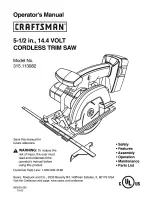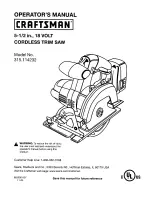
8
7.0
Location and Assembly
1. Remove bolts securing Band Saw to shipping
pallet.
2. Leave any packing material between vice
clamps and saw head intact until band saw
has been moved to its final position.
3. Lift the machine carefully with a hoist or forklift.
(Lifting eyes are mounted at the front of the
machine’s frame, and holes in the rear section
for insertion of a lifting rod.)
4. Make sure the floor will support the weight of
the machine. For best performance, the band
saw should be located on a solid and level
foundation of reinforced concrete. Allow
enough room on all four sides of the machine
for general servicing and for handling material.
5. When the band saw is in position, use a
machinist level on the vise side plates and
work feed table, and adjust front-to-back and
side-to-side with the provided leveling bolts.
NOTE: You may wish to adjust the back of the
machine slightly higher than the front (no more
than 3/8”). This will facilitate good coolant
return, as well as enhance material feed. Also,
you may wish to adjust the left of the saw
slightly higher than the right, which will also
assist coolant flow.
6. Secure the band saw to the floor with anchor
bolts, or rest it upon the foot pads and leveling
screws.
7. Clean all rust-protected surfaces with a soft
cloth dampened with a cleaner/degreaser. Do
not use highly flammable solvents such as
gasoline, paint thinner or acetone. Avoid
abrasive pads as they may scratch polished
metal surfaces.
8. Lubricate all slideways with a light film of
Mobil® DTE Oil Heavy Medium.
IMPORTANT:
This machine must have proper
coolant and hydraulic fluid levels before being
operated. Refer to the maintenance and lubrication
sections of this manual.
8.0
Electrical Connections
Electrical connections must
be made by a qualified electrician in
compliance with all relevant codes. This
machine must be properly grounded to help
prevent electrical shock and possible fatal
injury.
8.1
230V Operation
The Band Saw is equipped with a three phase,
230/460 volt motor; it is pre-wired 230V. You may
either install a UL/CSA listed plug suitable for 230
volt operation, or “hard-wire” the Band Saw directly
to a service panel.
If the Band Saw is to be hard-wired to a panel,
make sure a disconnect is available for the
operator. During hard-wiring of the machine, make
sure the fuses have been removed or the breakers
have been tripped in the circuit to which the Band
Saw will be connected. Place a warning placard on
the fuse holder or circuit breaker to prevent it being
turned on while the machine is being wired.
It is recommended that the AB-1012W three phase
Band Saw, when operated at
230 volts
, be
connected to a dedicated,
minimum
20 amp circuit
with a 20 amp circuit breaker or time delay fuse.
Local codes take precedence over recom-
mendations.
8.2
460V Operation
The Band Saw may be re-connected for 460 volt
operation as follows:
1. Re-connect the leads in the junction boxes on
each of the three motors (blade motor,
hydraulic motor, and coolant pump motor).
Follow the diagram on the inside cover of each
junction box.
2. In the electrical box, remove the blade motor
controller-inverter and replace it with an
inverter rated for 460V operation (additional
purchase, part number AB1012W-U2-A).
3. Remove the two overload relays (hydraulic
motor overload and coolant pump overload),
and replace them with relays rated for 460V
operation (additional purchase, part #
AB1012W-FS2-A and AB1012W-FS3-A).
4. Re-connect the wire at the transformer from
the 220V terminal to the 415V terminal.
5. Replace the fuses, including the transformer
fuses, with fuses appropriate for 460V
operation (additional purchase).
6. Connect the saw to power and test run. If the
blade runs in the wrong direction,
disconnect
power
, and switch any two of the three leads
to the blade motor.
It is recommended that the AB-1012W three phase
Band Saw, when operated at 460 volts, be
connected to a dedicated, minimum 15 amp circuit
with 15 amp circuit breaker or time delay fuse.
Local codes take precedence over
recommendations.
Summary of Contents for AB-1012W
Page 27: ...27 19 1 1 Base Assembly Exploded View...
Page 30: ...30 19 2 1 Bow Assembly Exploded View...
Page 34: ...34 19 3 1 Vise Transfer Assembly Exploded View...
Page 37: ...37 19 4 1 Vise Gearbox Assembly Exploded View...
Page 40: ...40 19 5 1 Bearing Guide and Brush Assemblies Exploded View...
Page 42: ...42 19 6 1 Accessories Exploded View...
Page 44: ...44 19 7 1 Electric Box and Control Panel Assembly Exploded View...
Page 47: ...47 20 0 Electrical Connections...
Page 48: ...48...
Page 49: ...49...
Page 50: ...50...









































